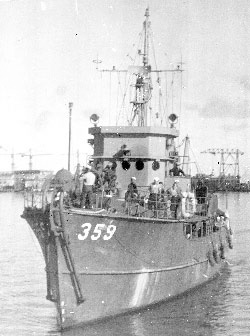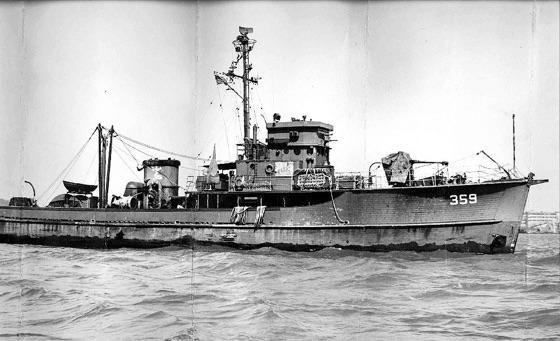YMS-359

YMS-359 Minesweeper
The first “Yard class Minesweeper (YMS)” was built in the Henry B. Nevins Inc. Shipyard, in City Island, New York. The keel of the YMS-1 was laid March 4, 1941 and she was launched on January 10, 1942, but completely finished two months later on March 25, 1942.
A total of 561 minesweepers were built for the war with 481 serving the US Navy and 80 serving the British (BYMS).
The length of the YMS class boat is, 136 feet, beam 24 feet 6 inches, Draft 8 feet (6 foot 3 inches for the 359), and they displaced 270 tons. With their two 880 BHP (Brake Horsepower) General Motors diesel engines (2 shafts) they could reach speeds up to 15 knots. The armament consisted of, one 3” .50 caliber gun mount, two 20 mm guns, and two depth charge projectors.
The 481 minesweepers serving the US Navy had generally the same characteristics, with the only variation being one of appearance. YMS-1 through 134 had two stacks, 135 through 445 along with 480 and 481 had one stack, while YMS-446 through 479 had no stack.
Originally rated as service craft, the minesweepers were used during WWII for inshore sweeping to prepare the way for amphibious assaults.

It is true nothing happened by the way of naval action without the aid of the minesweeper. Without them no sea bound invasion could have taken place until the path had been cleared of all mines. The minesweeper also had the hazardous task of removing these unseen killers. With this, the minesweeper crew had a motto, “…wherever the fleet goes, we’ve been!”
The YMS-class mine sweeper not only enjoyed the greatest number of units built to a common design, but managed to serve every Allied Navy from 1942 well into the late 1970s. Nearly a quarter of all ship losses in WWII were caused by mines, thus reinforcing the minesweepers importance. Every minesweeper crewman endured extraordinary dangers making navigable waters safe, and although little recalled today, the minesweeper’s role in naval warfare was the reason so many YMS class had to be built and deployed from the Aleutians to Cape Horn.
The YMS-359’s keel was laid Sept. 12, 1942 in City Island, New York by Robert Jacob Inc., launched April 9, 1943 and completed on August 20, 1943. The YMS-359 (Mine Squadron 11, Task Group 80-10) was in active service from July 14, 1943 to May 10, 1946.
The Commanding Officer, Lt. Murphy, operated the 359 in the allied invasion of France. During the follow up phase of the invasion of Southern France, the YMS-359 was tasked with the sweeping for enemy mines in the channel to Menton(e) France.
She was decommissioned May 10, 1946, and “retained in status as a power barge to be manned and operated by crews of ships receiving power”. Later in a memo from Commander Lockhart, he states, “Not essential to defense of United States, authority granted by SecNav to dispose of vessel”.
According to The Department of the Navy, the 359 was struck from the Naval Register on February 7, 1947.

Hatch’s daughter, Jeannie Helen Gravenkemper states, "The business took quite a while to get off the ground, they bought a lot of Navy surplus after the war. The government would have auctions, and they bought literally tons and tons and tons of material. My father was very savvy and very good at bidding." Hatch and Kirk Inc. become quite profitable selling heavy-duty diesel equipment abroad as well as back to the U.S. Government.
Marshall Hatch just recently died on Jan. 26, 2008. Hatch was an avid art collector and board president of Seattle Art Museum from 1982 to 1986 and was a longtime patron of the Museum of Northwest Art.
With records still being sifted through, the 359 ended up in the hands of Clif Gazaway.
Gazaway, a student at the University of Washington, bought the minesweeper with the idea of refurbishing the old boat into a retirement live aboard. His dream was to recruit some other Navy sailors to help him rebuild and then sail around the world on their retirement money. He hoped each sailor he could recruit would help, financially and physically, restore the minesweeper to seaworthy and livable status.
Unfortunately, according to rumors, a heater of some kind started a fire in the living quarters, and after that the University, who owned the site the 359 was moored at, wanted the ship gone.
The YMS-359 simply disappeared after the incident.

The YMS-359 lies off of of Magnuson Park straight out from Houghton, in 200 feet of water.





-
-Home
